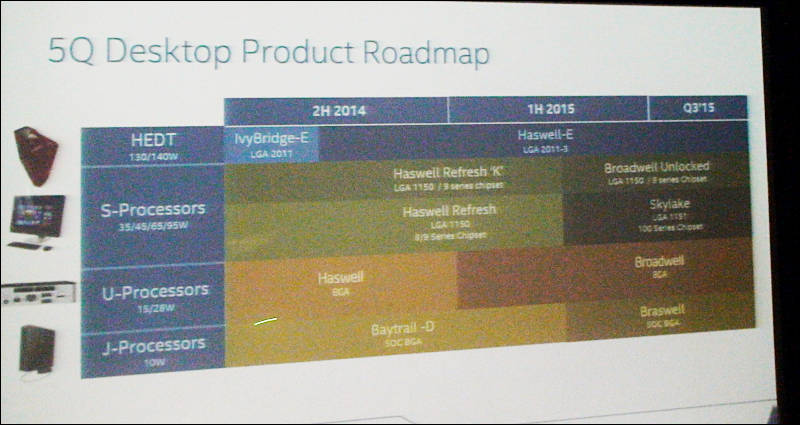
-
Broadwell chip that Intel CEO Brian Krzanich promised to ship before the holiday season might not be the real McCoy. As you can imagine chip development takes a lot of time and effort and shrinking the Haswell architecture from 22nm and turning it into Broadwell at 14nm is not as easy as it sounds.
The original Broadwell design that got pushed back had to be slimmed down in order to get better yields. The chip can end up better than all Haswell chips that you can buy today in the mobile space, but Intel had more ambitious plans that could not realise in time.
After Broadwell the next ‘tock’ is called Skylake. Skylake was originally supposed to come in 2015 and should be based on a new architecture, but with the Broadwell delay Intel might postpone the follow-on chip
http://fudzilla.com/home/item/34824-broadwell-coming-this-year-is-a-slimmed-down-version
-
Intel Broadwell-K (desktop ones) processors shifted again, now to Q3 2015.
It is fun how processor giant fights physics spending more and more while getting less and less.
-
I'm both surprised and disappointed that there is no reasonably priced 8 core with h/t available from Intel.
It is all to do with thermal package mostly :-)
Plus they have Xeons :-)
-
I'm both surprised and disappointed that there is no reasonably priced 8 core with h/t available from Intel.
Even before Broadwell:
The top octo-core Haswell-E chip, the Core i7 5960X, will come in at $999, in line with the way Intel have previously priced their Extreme Edition processors.
The other two Haswell-E chips are going to be missing those two extra cores . The $500 for i7 5930K.
-
In terms of CPU performance, a 5th-gen Intel Core “Broadwell” processor will be just about 5 percent faster than an equivalent 4th-gen Intel Core “Haswell” processor running at the same clock speed.
More details about CPUs at
- http://arstechnica.com/gadgets/2014/08/broadwell-is-coming-a-look-at-intels-low-power-core-m-and-its-14nm-process/
- http://newsroom.intel.com/community/intel_newsroom/blog/2014/08/11/intel-discloses-newest-microarchitecture-and-14-nanometer-manufacturing-process-technical-details
- http://www.anandtech.com/show/8355/intel-broadwell-architecture-preview
-
I vividly remember the time when there was good reason to buy a new computer like every 2 years, because technology got so much better rapidly. Today, I'd not have to think as much about the cost of buying a new computer, and yet I see less and less reason to upgrade/replace even 5 year old machines. The last real "wow"-effect to me came not from CPUs, but from SSDs, now that all of my computers are equipped with SSDs, I wonder how long it will take until there's enough progress to be seen that it tickles me to buy a new computer.
-
I'm sick of my 2600k. It's been running at 5ghz since late 2011. I have it watercooled and it ramps up the voltage when needed, so it's not really that power hungry during normal usage. Rendering at 5ghz is just simply not fast enough. I hope the 5960x @ 4.5ghz will give at least the same single threaded performance of the 2600k at 5ghz with the benefit of 8 cores for rendering.
-
Some useful slides
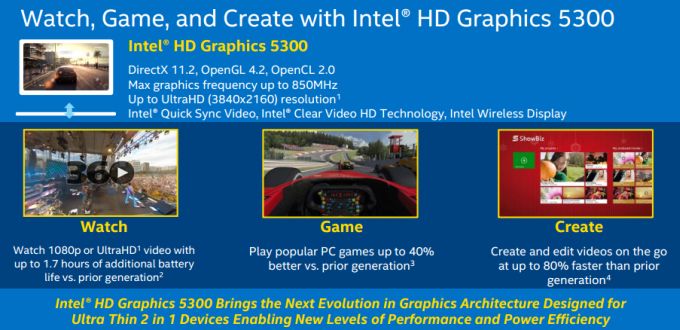
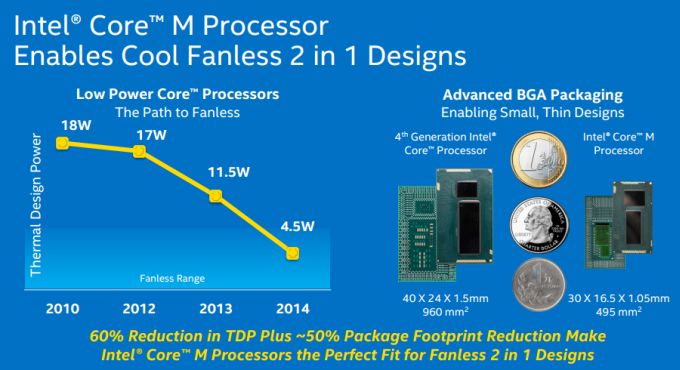
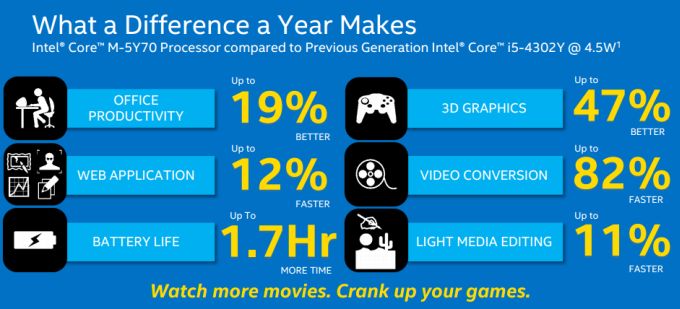
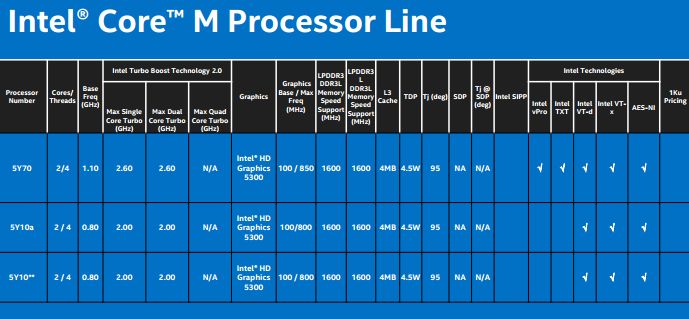

 core-m_1.jpg680 x 330 - 52K
core-m_1.jpg680 x 330 - 52K
 core-m_2.jpg680 x 370 - 44K
core-m_2.jpg680 x 370 - 44K
 core-m_3.jpg680 x 309 - 42K
core-m_3.jpg680 x 309 - 42K
 core-m_4.jpg689 x 319 - 40K
core-m_4.jpg689 x 319 - 40K -
The transition to 14nm manufacturing technology took about a year longer than expected due to issues with defect densities. Intel admits that it has run into major problems with 14nm process technology and claims that going forward transitions could become even more difficult.
“The move from 20nm down to 14nm has gotten harder, it has taken us longer than we wanted to,” said Mr. Krzanich. “The technologies are harder, the defects actually what has become very difficult is the pattering itself the amount of interference patterns you have to engineer through to make an image now.”
-
Well, it seems to be that difference is around 2-3%
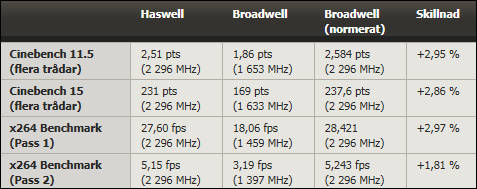

 rose6.jpg477 x 189 - 29K
rose6.jpg477 x 189 - 29K -
Due to issues surrounding the 14nm node, as well as the cost, the whole Broadwell line from tablet to table-top has come out slower and more staggered than any Intel release in recent memory. As a result, the initial launch from Intel today is a pair of 65W desktop socketed models backed up with three 65W soldered down models whose true heritage is a chip primarily designed for large laptops and all-in-one devices
http://www.anandtech.com/show/9320/intel-broadwell-review-i7-5775c-i5-5765c/10
Howdy, Stranger!
It looks like you're new here. If you want to get involved, click one of these buttons!
Categories
- Topics List23,992
- Blog5,725
- General and News1,354
- Hacks and Patches1,153
- ↳ Top Settings33
- ↳ Beginners256
- ↳ Archives402
- ↳ Hacks News and Development56
- Cameras2,367
- ↳ Panasonic995
- ↳ Canon118
- ↳ Sony156
- ↳ Nikon96
- ↳ Pentax and Samsung70
- ↳ Olympus and Fujifilm101
- ↳ Compacts and Camcorders300
- ↳ Smartphones for video97
- ↳ Pro Video Cameras191
- ↳ BlackMagic and other raw cameras116
- Skill1,960
- ↳ Business and distribution66
- ↳ Preparation, scripts and legal38
- ↳ Art149
- ↳ Import, Convert, Exporting291
- ↳ Editors191
- ↳ Effects and stunts115
- ↳ Color grading197
- ↳ Sound and Music280
- ↳ Lighting96
- ↳ Software and storage tips266
- Gear5,420
- ↳ Filters, Adapters, Matte boxes344
- ↳ Lenses1,582
- ↳ Follow focus and gears93
- ↳ Sound499
- ↳ Lighting gear314
- ↳ Camera movement230
- ↳ Gimbals and copters302
- ↳ Rigs and related stuff273
- ↳ Power solutions83
- ↳ Monitors and viewfinders340
- ↳ Tripods and fluid heads139
- ↳ Storage286
- ↳ Computers and studio gear560
- ↳ VR and 3D248
- Showcase1,859
- Marketplace2,834
- Offtopic1,320




